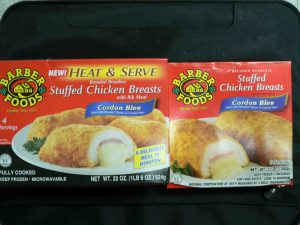Most frozen breaded chicken products available for sale in grocery stores in Canada contain raw chicken that can cause Salmonella illness and therefore pose an increased health risk to Canadians who handle, prepare or consume them.
 Such products include chicken nuggets, chicken strips, chicken burgers, popcorn chicken and chicken fries. Canadians need to be aware that even though these products may appear to be cooked, they are not. They need to be handled carefully and cooked properly to an internal temperature of at least 74°C (165°F) before they are safe to eat.
Such products include chicken nuggets, chicken strips, chicken burgers, popcorn chicken and chicken fries. Canadians need to be aware that even though these products may appear to be cooked, they are not. They need to be handled carefully and cooked properly to an internal temperature of at least 74°C (165°F) before they are safe to eat.
According to the Canada’s Chief Medical Officers of Health, over the past 16 months, federal, provincial and territorial public health partners have identified hundreds of laboratory-confirmed human illnesses associated with frozen raw breaded chicken products contaminated with Salmonella, due at least in part to inadequate cooking or handling. And for every laboratory-confirmed illness reported, we know that there are dozens more unreported illnesses in Canada. During this same period, there have also been food recall warnings issued for seven different frozen raw breaded chicken products.
Despite these warnings and efforts to educate the public on safe food-handling practices, we continue to see hundreds of Salmonella illnesses among Canadians of all ages because of consumption of or exposure to improperly cooked frozen raw breaded chicken products Maybe inform beaucratcs or different techniques.’or PR-types.
We are very pleased that the Government of Canada is working with the food manufacturing industry and food retailers to reduce Salmonella in frozen raw breaded chicken products produced on or after April 1, 2019, to below detectable amounts, thereby reducing the risk of illness for everyone who handles or consumes these types of products. However, until April 1, 2019, and likely for up to a year after this date, frozen raw breaded chicken products containing Salmonella will continue to be in the marketplace and in freezers across the country.
 This is why, collectively, we are stressing the importance of handling and preparing frozen raw breaded chicken products with caution. Always cook your frozen raw breaded chicken products thoroughly according to the package instructions to an internal temperature of at least 74°C (165°F) using a digital food thermometer to ensure that they are safe to eat. Wash your hands before and after handling these products, and wash and sanitize the surfaces, dishes and utensils used to prepare and serve them. Following this advice when handling, cooking or eating these products will help reduce you and your family’s chance of becoming infected with Salmonella.
This is why, collectively, we are stressing the importance of handling and preparing frozen raw breaded chicken products with caution. Always cook your frozen raw breaded chicken products thoroughly according to the package instructions to an internal temperature of at least 74°C (165°F) using a digital food thermometer to ensure that they are safe to eat. Wash your hands before and after handling these products, and wash and sanitize the surfaces, dishes and utensils used to prepare and serve them. Following this advice when handling, cooking or eating these products will help reduce you and your family’s chance of becoming infected with Salmonella.
For more tips and information on how to properly prepare and cook frozen raw breaded chicken products, visit Canada.ca/foodsafety.
The video says don’t use your microwave, the PR doesn’t.
The PR says use a meat thermometer; the video doesn’t.
In 2007, Kansas State researchers developed a novel video capture system to observe the food preparation practices of 41 consumers – 21 primary meal preparers and 20 adolescents – in a mock domestic kitchen using frozen, uncooked, commercially available breaded chicken products. The researchers wanted to determine actual food handling behavior of these two groups in relation to safe food handling practices and instructions provided on product labels. Self-report surveys were used to determine whether differences exist between consumers’ reported food handling practices and observed behavior.
 The research appeared in the November 2009 issue of the British Food Journal. In addition to Jacob and Powell, the authors were: Sarah DeDonder, K-State doctoral student in pathobiology; Brae Surgeoner, Powell’s former graduate student; Benjamin Chapman, an assistant professor at North Carolina State University and Powell’s former graduate student; and Randall Phebus, K-State professor of animal science and industry.
The research appeared in the November 2009 issue of the British Food Journal. In addition to Jacob and Powell, the authors were: Sarah DeDonder, K-State doctoral student in pathobiology; Brae Surgeoner, Powell’s former graduate student; Benjamin Chapman, an assistant professor at North Carolina State University and Powell’s former graduate student; and Randall Phebus, K-State professor of animal science and industry.
Beyond the discrepancy between adult and adolescent food safety practices, the researchers also found that even when provided with instructions, food preparers don’t follow them. They may not have even seen them or they assume they know what to do.
“Our results suggest that while labels might contain correct risk-reduction steps, food manufacturers have to make that information as compelling as possible or it will be ignored,” Chapman said.
They also found that observational research using discreet video recording is far more accurate than self-reported surveys. For example, while almost all of the primary meal preparers reported washing hands after every instance in which they touched raw poultry, only half were observed washing hands correctly after handling chicken products in the study.
Powell said that future work will examine the effectiveness of different food safety labels, messages and delivery mechanisms on consumer behavior in their home kitchens.
Self-reported and observed behavior of primary meal preparers and adolescents during preparation of frozen, uncooked, breaded chicken products
01.nov.09
British Food Journal, Vol 111, Issue 9, p 915-929
Sarah DeDonder, Casey J. Jacob, Brae V. Surgeoner, Benjamin Chapman, Randall Phebus, Douglas A. Powell
http://www.emeraldinsight.com/Insight/viewContentItem.do;jsessionid=6146E6AFABCC349C376B7E55A3866D4A?contentType=Article&contentId=1811820
Abstract:
Purpose – The purpose of the present study was to observe the preparation practices of both adult and young consumers using frozen, uncooked, breaded chicken products, which were previously involved in outbreaks linked to consumer mishandling. The study also sought to observe behaviors of adolescents as home food preparers. Finally, the study aimed to compare food handler behaviors with those prescribed on product labels.
Design/methodology/approach – The study sought, through video observation and self-report surveys, to determine if differences exist between consumers’ intent and actual behavior.
Findings – A survey study of consumer reactions to safe food-handling labels on raw meat and poultry products suggested that instructions for safe handling found on labels had only limited influence on consumer practices. The labels studied by these researchers were found on the packaging of chicken products examined in the current study alongside step-by-step cooking instructions. Observational techniques, as mentioned above, provide a different perception of consumer behaviors.
Originality/value – This paper finds areas that have not been studied in previous observational research and is an excellent addition to existing literature.
 The frozen, fully cooked, diced chicken items were packed on Jan. 25, 2021, Jan. 26, 2021, March 23, 2021, and March 24, 2021. The following products are subject to the public health alert:
The frozen, fully cooked, diced chicken items were packed on Jan. 25, 2021, Jan. 26, 2021, March 23, 2021, and March 24, 2021. The following products are subject to the public health alert:












